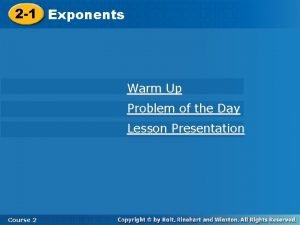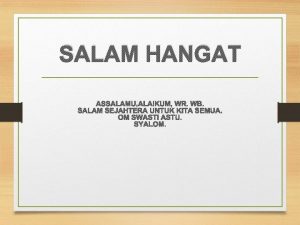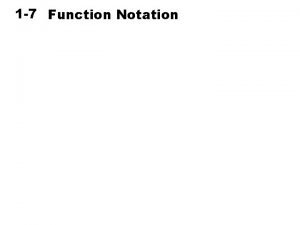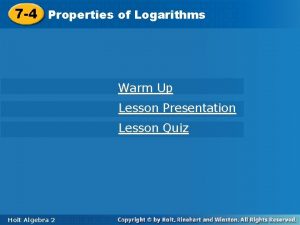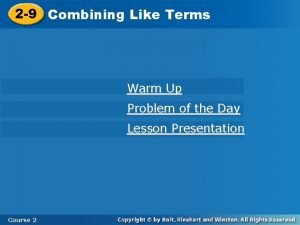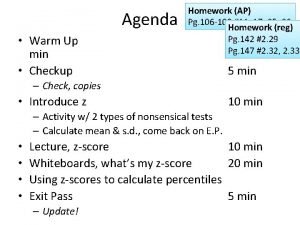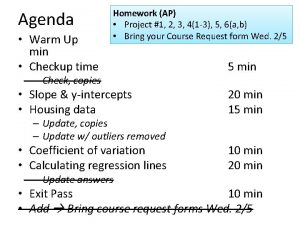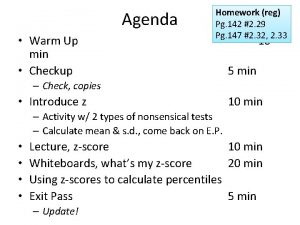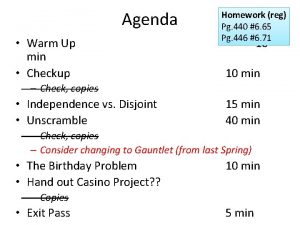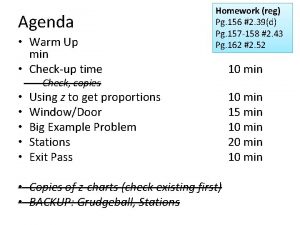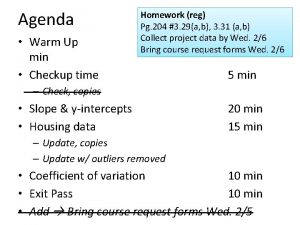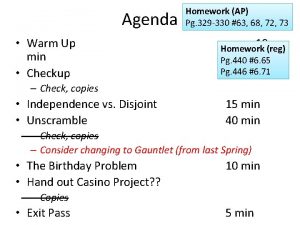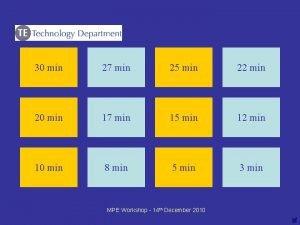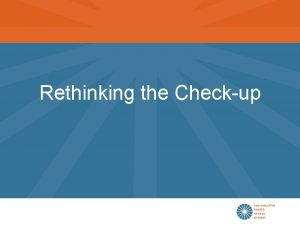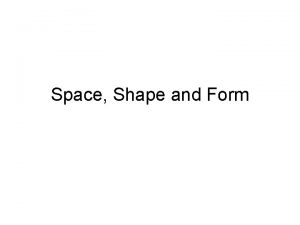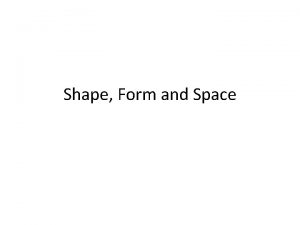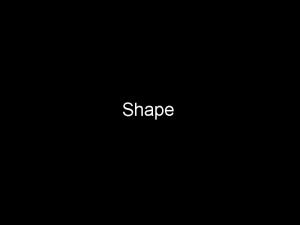Agenda Warm Up min WindowDoor shape min Checkup




















- Slides: 20

Agenda • Warm Up min • Window/Door, shape min • Checkup Homework (reg) Pg. 75 #1. 29, 1. 31 Pg. 84 #1. 3710 Pg. 89 #1. 43 10 10 min – Check, copies • Lecture, center and spread 30 min – Spread, s. d. vs. 5# summary – Update data w/ salary expectations • How long is a minute 20 min – Set up • Exit Pass 10 min

Warm Up Sign up for our Remind: Text to 81010, message: @602 reg 2020 1. Which of the following are true statements? I. Stemplots are useful both for quantitative and categorical data sets. II. Stemplots are equally useful for small and very large data sets. III. Stemplots can show symmetry, gaps, clusters, and outliers. A) I only B) II only C) III only D) I and II E) I and III 2. If 10 executives have salaries of $80, 000, 6 have salaries of $75, 000, and 3 have salaries of $70, 000, what is the median salary? A) $75, 000 B) $76, 842 C )$77, 500 D) $80, 000 E) none of these 3. Which of the following statements are true? I. Two students working with the same data may come up with histograms that look different. II. Displaying outliers is less problematic when using histograms than when using stemplots. III. Histograms are more widely used than stemplots or dotplots because histograms display the values of individual observations. A. ) I only B. ) II only C. ) III only D. ) I and II E. ) II and III

Back-to-School night 5: 30 -6: 15 -6: 25 6: 30 -6: 40 6: 50 -7: 00 7: 10 -7: 20 7: 30 -7: 40 Music/food/shopping AFROTC Flag Presentation Period 1 Period 2 Period 3 Period 4

Window/Door – “What’s the Shape”? Consider the following variables on which you could gather data from students at RCHS. For each, describe the shape of the distribution. Skewed right/left, or symmetric? Justify. 1. EXAMPLE: Number of pairs of shoes owned 2. Number of siblings 3. Price paid for most recent haircut 4. Number of T-shirts owned 5. Distance from place of birth 6. Age 7. Amount paid on the student’s last visit to a grocery store 8. Last digits of cell phone number 9. Duration of most recent phone conversation

Checkup time

Describing Distributions with Numbers SOCS “Center” and “Spread”

Measures of Center Mean 4. 761 hours Only when data is ~symmetric! vs. Median 3. 5 hours 0 0. 75 1 2 2. 5 3 4 4 4 5 5 10 10 10 17

Poverty Thresholds for 2016 Related children under 18 years 0 1 2 3 4 5 6 7 8+ Size of family unit One person Two people Three people 12, 331 15, 871 16, 337 18, 540 19, 078 19, 096 Four people 24, 447 24, 847 24, 036 24, 120 Five people 29, 482 29, 911 28, 995 28, 286 27, 853 Six people 33, 909 34, 044 33, 342 32, 670 31, 078 Seven people 39, 017 39, 260 38, 421 37, 835 36, 745 35, 473 34, 077 Eight people Nine people or more 43, 637 44, 023 43, 230 42, 536 41, 551 40, 300 38, 999 38, 668 52, 493 52, 747 52, 046 51, 457 50, 490 49, 159 47, 956 47, 658 45, 822 Source: U. S. Census Bureau.

Salary expectations (P. 2) How much do you expect to make for your annual salary in your first year of full-time employment? 1. Calculate the mean and median. 2. Suppose a new student expects to earn $1 billion(!) as the leader of a world-wide empire. Which is affected more, the mean or median? 3. Not including the new student, suppose all your estimates are increased by $5000. How might this affect the mean and median? Period 2 $10, 000 $22, 500 $25, 000 $30, 000 $36, 000 $40, 000 $45, 000 $53, 000 $70, 000 $77, 500 $80, 000 $100, 000 $150, 000

Everything is on the calculator! • Type data into List at STAT 1: Edit Period 2 $10, 000 $22, 500 $25, 000 $30, 000 $36, 000 $40, 000 $45, 000 $53, 000 $70, 000 $77, 500 $80, 000 $100, 000 $150, 000

Everything is on the calculator! • Type data into List at STAT 1: Edit • Numerical summary – Mean, standard deviation, 5# summary…. – STAT CALC 1: 1 -Var Stats Period 2 $10, 000 $22, 500 $25, 000 $30, 000 $36, 000 $40, 000 $45, 000 $53, 000 $70, 000 $77, 500 $80, 000 $100, 000 $150, 000

Notes 1 of 3 5 -number summary • Minimum • First quartile “Interquartile range” n = 30 n = 28 “Ran ge” (25 th percentile) • Median • Third quartile (75 th percentile) • Maximum 1. 5 x IQR Rule for Outliers An observation is an outlier if it falls more than (1. 5 x. IQR) above Q 3 or below Q 1 – (1. 5 x. IQR) Q 3 + (1. 5 x. IQR) Min 0 Q 1 0 Med 2 Q 3 3 Max 59 P. 2 0 0 0 0 0 1 1 1 2 2 2 2 3 3 3. 5 4 5 5 8 9

Window/Door Identify any outliers in the data sets: No outliers, 19+24=43 1. 0, 3, 8, 13, 19, 40 2. 0, 3, 8, 13, 19, 44 44 is outlier, 19+24=43 3. 0, 5, 15, 25, 35, 75 No outliers, 35+45=80 4. -15, -7, 0, 35, 100, 120, 150, 355 is an outliers, 135+219=354

Notes 2 of 3 Standard Deviation • Average distance from mean. – Average of the squares of the “deviations” from the mean • Only use when the mean is chosen as the measure of center 2. 25 • Sensitive to outliers or 1. 54 P. 2 0 0 0 0 0 1 1 1 2 2 2 2 3 3 3. 5 4 5 5 8 9

Notes 3 of 3 P. 2 0 2 0 2 0 3 0 3 0 3 1 1 3. 5 4 1 5 2 8 2 9 Boxplot • Represent 5 -number summary on # line • “Modified boxplot” = outliers shown Min 0 Q 1 0 Med 2 Q 3 3 Max 0 1 2 3 4 5 6 7 9 5 8 9 10 11

Period 2 $10, 000 $22, 500 $25, 000 $30, 000 Mean, standard deviation, 5# summary…. $36, 000 $40, 000 STAT CALC 1: 1 -Var Stats $40, 000 $45, 000 $53, 000 2 nd STAT PLOT Enter (Turn Plot ON) $70, 000 • Histogram is graph type #3 $70, 000 • Modified boxplot (shows outliers) is graph type #4 $77, 500 $80, 000 • Boxplot is graph type #5 $80, 000 Can’t see graph? Try ZOOM 9: Zoom. Stat $80, 000 $100, 000 $150, 000 Everything is on the calculator! • Type data into List at STAT 1: Edit • Numerical summary – – • Histograms and boxplots – –

How long is a minute? • You and your partner will need 1 watch/timer • Door Tell Window to start counting 1 minute • Window When you think it’s been a minute, say “Stop” quietly. • Door Write down time in seconds – Do NOT tell partner how much time passed • Two trials, then switch roles. • Do not reveal your data to anyone else, including your partner.

How long is a minute? Give me your estimates. In L 1, enter the first estimates of the class: 1. Both partners. Use your calculator to make a modified boxplot of the class’ first estimates. Compare calculators. 2. Both partners. Use your calculator to make a histogram. Compare calculators. 3. DOOR. Describe the distribution to your partner. In L 2, enter the averages of the class: 1. Both partners. Use your calculator to make 2 simultaneous modified boxplots of both the first estimates and average estimates. Compare calculators. 2. Both partners. Use your calculator to 2 simultaneous histograms of both the first estimates and average estimates. . Compare calculators. 3. WINDOW. Compare these two distributions.

How long is a minute? I will ask you to read all three of your own estimates. Using the first estimates of the class: 1. Both partners. Use your calculator to make a modified boxplot of the class’ first estimates. Compare your calculators. 2. DOOR. Describe the distribution to your partner. Using the averages of the class: 1. Both partners. Use your calculator to make a histogram of the class’ average estimates. Compare your calculators. 2. WINDOW. Describe the distribution to your partner.

Exit Pass (P. 2) Homework (reg) Pg. 75 #1. 29, 1. 31 Pg. 84 #1. 37 Pg. 89 #1. 43 1. Create a 5 -number summary of the data. 2. Sketch a modified boxplot of the data. Period 2 $10, 000 $22, 500 $25, 000 $30, 000 $36, 000 $40, 000 $45, 000 $53, 000 $70, 000 $77, 500 $80, 000 $100, 000 $150, 000
 Agenda sistemica y agenda institucional
Agenda sistemica y agenda institucional Bolongie
Bolongie Aerodynamic shape vs aerofoil shape
Aerodynamic shape vs aerofoil shape Shape matching and object recognition using shape contexts
Shape matching and object recognition using shape contexts Act warm up questions
Act warm up questions Is the path warm
Is the path warm Exponents warm up
Exponents warm up Warm season crops
Warm season crops Warm up questions
Warm up questions Warm bath theory
Warm bath theory Mechanical weathering is more rapid in warm wet climates
Mechanical weathering is more rapid in warm wet climates Warm greetings meaning
Warm greetings meaning Function notation table
Function notation table Density warm up
Density warm up Warm up paper
Warm up paper Harry potter warm up
Harry potter warm up 7-4 properties of logarithms
7-4 properties of logarithms Combining like terms warm up
Combining like terms warm up Caloric test
Caloric test Fun warm up games gaa
Fun warm up games gaa Lets warm up
Lets warm up






